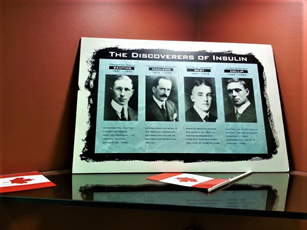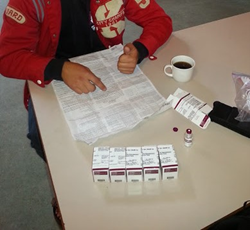Chronically Growing with Diabetes: Chronic Costs of Insulin
- Nov 15, 2020
- 3 min read
by Katie Little, Institute Fellow
Living with a chronic condition, such as Type 1 or Type 2 diabetes, comes along with chronic costs. The reality for most people with diabetes is that these costs can vary widely depending on where you live, what you do for work, your age, your access to health care, and your access to insurance coverage. Regardless of these variables, someone living with diabetes and needing insulin will need it daily, often multiple times a day, to stay alive.
The photos above were taken while working a summer of camp programs in Canada with the Canadian Diabetes Association. The history of the Canadian Diabetes Association, and the photo on the left, outlines Sir Frederick G Banting, Charles H Best, JJR Macleod, and James B Collip who are the individuals responsible for the discovery of pure human insulin in 1921. It was not until 1922 that insulin was successfully tested on a human patient.
The second photo is of a co-worker investigating insulin retrieved from two different areas, the US and Canada. We were comparing the boxes and manufacturing labels to see if there was any difference in the product. We didn’t notice any difference in the insulin formula but did realize that in Canada insulin could be obtained without a prescription and for a significant less amount of money compared to in the US.
Banting House outlines information related to the American patents for insulin being sold to the University of Toronto for only $1 each. During the sale of the patents, Banting said, “Insulin belongs to the world, not to me”. It is absurd to think that the man who discovered insulin wanted it to be accessible to all those who needed it. Unfortunately, that is not the case with insulin these days. It is not equally accessible to all who need it. For this reason, I have gathered some resources below that may help offset the high costs of insulin.
Additionally, your diabetes care team should know if you are struggling to pay for your insulin. They may have samples of insulin that you can request during your visit. Samples from your doctor are best to use if switching to a new type of insulin, or if you are starting to run short on insulin and should not be used as a long-term plan for securing your needed medication. Another option to consider would be to check with your pharmacy to see if they have their own prescription program for customers. Oftentimes, national drug stores and pharmacy chains (Costco, Target, CVS, Walmart, etc.) will offer their own prescription savings program for their customers.
Pharmaceutical Company Patient Assistance Programs
Lilly Cares Foundation
Johnson & Johnson
Novo Nordisk
Sanofi
Pharmaceutical Company Co-Pay Assistance Cards
Eli Lilly
Novo Nordisk
Sanofi
State Pharmaceutical Assistance Programs
Community Health Care Centers
Groups
Diabetics pay if forward USA
National Diabetic Pay It Forward
Diabetes Supplies Give & Take Southwest Michigan
T1D Paying it forward
T1D’s Swap
Passing it forward diabetes
Be A Part Of It
*Please consult with your diabetes care team for the best way to manage your diabetes. The author of this post does not condone the illegal redistributing or selling of prescription diabetes supplies. Other resources may exist that are not outlined in this post. If you have additional insulin resources that may be helpful to people living with Type 1 or Type 2 diabetes, or experiences with these insulin resources, please list them in the comments section below.
References:
.png)

